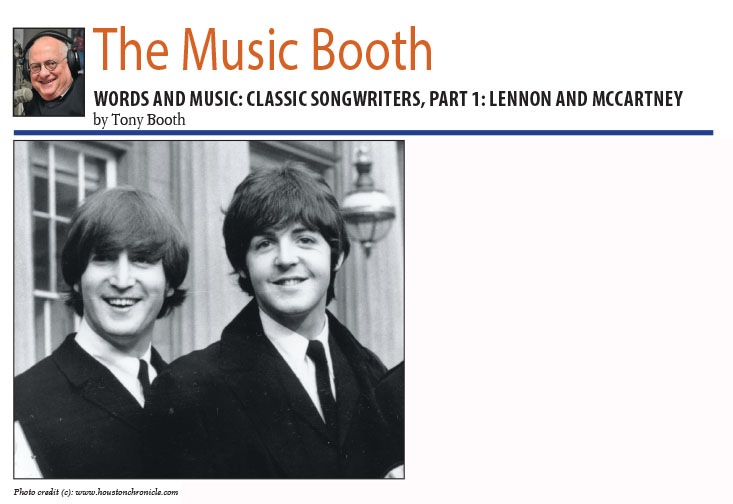
There are many factors which go into the making of a hit record. But nothing gets started until the songwriter(s) come up with a great set of lyrics and the composer comes up with the perfect vehicle. Then is when the singer does his or her interpretation.
Lyrics to a song are like a fine poem or short story. Brevity is the key to anything it seems in life and especially a song. In the 1950s and ’60s, songs were written to be 2 1/2 minutes or less. Otherwise, it was very difficult to get radio stations to play it as program directors felt the more music played, the more appealing the radio station. It wasn’t until the Beatles’ “Hey Jude” came out in 1968 that radio station did away with that rule of thumb.
The rock era has produced some of the finest songwriters in the history of American music. Many of the early songwriters of rock music wrote from the famed Brill Building in New York City. The building over the years rented to writers, publishing companies, Broadway Composers and the like since it had just opened in the late 1920s when the stock market crashed and the owners needed the business. The building didn’t have air conditioning so the singers and musicians would open up the windows to get a breeze. With all these various groups working on songs, it sounded like tin pans banging together at times. From that “noise” came the expression Tin Pan Alley.
Al Nevins and Don Kirshner’s publishing company was located in the Brill Building and was home to Gerry Goffin and Carole King, Berry Man and Cynthia Weil, Neil Sedaka and Howard Greenfield, Neil Diamond and countless others. They would pound away on pianos in small cubicles always within earshot of others writers working on similar tunes. At the end of the day, they gathered in one main room and played the songs they composed that day. Many were the hits that became the songbook of our lives. In 1963 alone, the names Goffin and King appeared in parentheses under the titles of hits by the Cookies, the Drifters, Freddy Scott, the Chiffons, Little Eva, Lesley Gore, Skeeter Davis, Steve Lawrence and many, many more. I dare say there is probably more than a handful of radio stations that today will play one of the many versions of Barry Mann and Cynthia Weil’s “You’ve Lost That Lovin’ Feeling,” originally done by the Righteous Brothers. By the way, that song was the most-performed song of the 20th century written at the Brill Building.
It will be up to future music historians to decide if Bacharach and the Beatles belong in the same category as Bach and Beethoven. But we already know the Lennon-McCartney songbook is still active some 45 plus years after the Beatles stopped recording as a group ... and that the Motown writing trio of Holland-Dozier-Holland catalog is just as attractive to artist today as it was with we first hear their songs sung by the Temptations, The Four Tops, the Marvelettes, the Supremes and others.
Thus, this Part One of a three-part series on songwriters. Part two is about a team, at the time husband and wife, whose songs dominated the radio airwaves and on your turntables at home in the late 1950s and early ’60s ... Carole King and Gerry Goffin. In part three, two of the best teams of songwriters, Jerry Lieber and Mike Stoller, and Holland-Dozier-Holland will be featured. Elvis sang many of their hits including a song Jerry Leiber and Mike Stoller wrote in just 15 minutes, “Hound Dog.” Holland-Dozier-Holland were part of a stable of writers who wrote hit after hit for the “Sound of Young America”-- Motown Records.
JOHN LENNON & PAUL McCARTNEY
“We wanted to be the Carole King and Gerry Goffin of England” is how Lennon-McCartney once described their goal as songwriters. They started writing about the same time as King and Goffin in the late 1950s. At first, most of their songs were freshmen efforts, but they would always write at the top of the page “Another Lennon-McCartney Original.”
The Beatles’ manager, Brian Epstein, suggested they stay away from original material when taking an audition tape to the record labels. In fact, their first 15 songs they recorded were covers of other songs. Decca Records hardly listened to the tape. That turned out to be one of the biggest blunders in rock history. Decca Records signed the Tremeloes instead; that band had a handful of hits and eventually disbanded.
Desperate to get the Beatles on the charts, Brian Epstein contacted George Martin, head of small label owned by EMI. Martin agreed to produce two Beatle songs that Lennon-McCartney wrote: “Please Please Me” and “Love Me Do.” On the strength of those two songs and a handful of others, Beatlemania exploded in the UK and in Europe in 1962-1963, but not here in America initially. It wasn’t until Feb. 9, 1964, on “The Ed Sullivan Show” when the four musicians from Liverpool formally introduced to America. Four of the five songs they performed that night were Lennon-McCartney compositions. The fifth song was “Till There Was You” from the Broadway musical “The Music Man.” Curiously, McCartney always liked Broadway songs but never knew that song was from a Broadway musical until the next day.
Not only did Lennon-McCartney write 95 percent or more of the band’s material, with George Harrison writing a handful, they wrote for other artists as well. Even today, bands cover many of the Beatle songs.
In Part Two of my three part series on the songwriters, it’s the songs of Carole King and Gerry Goffin.